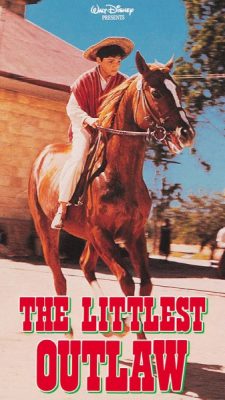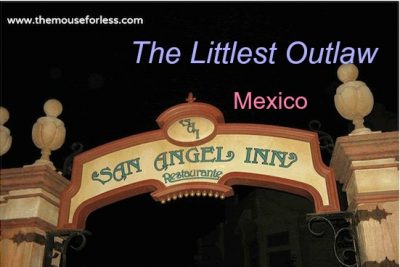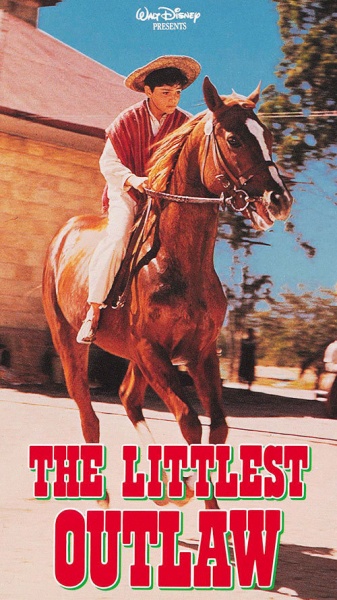
A live action drama based on an original story idea by Disney veteran Larry Lansburgh, The Littlest Outlaw was theatrically released on December 22, 1955. The film is seventy-three minutes in length. The Littlest Outlaw was Disney’s seventh completely live action feature film, following Treasure Island (1950), The Story of Robin Hood and His Merrie Men (1952), The Sword and the Rose (1953), Rob Roy, the Highland Rogue (1954), 20,000 Leagues Under the Sea (1954), and Davy Crockett, King of the Wild Frontier (1955).
The Littlest Outlaw incorporated bilingual actors such that unique English and Spanish versions of the film could be produced simultaneously. According to Disney Chief Archivist Emeritus Dave Smith, The Littlest Outlaw is the only Disney film produced in such a manner; many other Disney movies have been released abroad with dubbing or subtitles but not with the same actors from the English version speaking a different language. (1)
Plot Summary
In Mexico, General Torres (Pedro Armendáriz) prepares his horse Conquistador for an international equestrian competition. Though he is a great steed overall, Conquistador struggles with jumping, always grazing the top of the obstacle that he must hurdle. Seeing the problem, Torres orders his horse trainer, Chato (Rodolfo Acosta), to continue practice runs. Practice may make perfect, but Chato recklessly exceeds Torres’s instructions through two acts. First, Chato, who is in dire straits financially, places several bets on the general’s horse. Then, with his livelihood now dependent on a victory from Conquistador, the trainer situates a spiked pole at the top of the practice wall to scare the horse into jumping higher. Chato’s gamble badly backfires; at the competition, rather than jumping higher, a terrified Conquistador refuses to leap at all.
Back at Torres’s ranch after the tournament, Celita (Laila Maley), the general’s young daughter, insists that Chato’s young stepson, Pablito (Andrés Velázquez), allow her to ride Conquistador such as to help the horse overcome its fear of jumping. Pablito, having been ordered by Torres and Chato not to release Conquistador from his stable, only reluctantly agrees to Celita’s demand, a decision that turns disastrous when the horse strikes the wall and flings the girl to the ground, potentially leaving her paralyzed. Devastated over his daughter’s condition, Torres demands that Chato kill Conquistador. However, at this critical moment, Pablito makes a daring decision: knowing that his cowardly stepfather caused all the problems, the boy takes the horse and flees the ranch. Pablito and Conquistador are now fugitives. They do not know where they are going or how they will survive. Can they survive without returning to face Torres’s wrath?
Characterization
The Littlest Outlaw would have benefited from more thorough character development. The film contains lots of action, but the characters largely appear with minimal context and are not very relatable. The emergence of the hostile relationship between Pablito and Chato, and the potential friendship between Pablito and Celita, for example, could have been explored in more depth.
Decisions
Throughout The Littlest Outlaw, Pablito faces difficult decisions. While the boy’s decision to run away with Conquistador undoubtedly saved the horse’s life, Pablito committed a crime by stealing the general’s property. Furthermore, the animal is ill and will not persist much longer without medical care regardless of how far Pablito removes him from the general’s estate. Pablito arguably made the correct first move in running away, but has the situation changed? Is there a chance that the general has collected his emotions and will now spare the horse? Pablito must find the courage to take the correct path.
Larry Lansburgh
The story for The Littlest Outlaw was the work of veteran Disney director Larry Lansburgh, who was named a Disney Legend in 1998. Lansburgh, an animal lover who ironically came to the Disney Studio after falling off a horse while doing stunt work for a movie in 1937, had accompanied Walt Disney on his government-sponsored 1941 trip to Latin America and shot some of the footage that was incorporated into Saludos Amigos (1942). Thereafter, Lansburgh became known for his expertise in producing animal-centered shorts and features, including “Stormy, the Thoroughbred” (1954) and “The Wetback Hound” (1957). (2)
Lansburgh’s experience in shooting documentaries positively affected the quality of The Littlest Outlaw’s horse-riding and bullfighting segments; the cameras catch the happenings from various angles, and the juxtaposition of the resulting shots provides viewers with a maximum emotional impact. (3) In the opening scenes, for example, an overhead shot of horses running down a hill and over a gap is followed by a ground shot of the horses on the other side of the crack. The latter shot, in turn, is succeeded by quick shots of horses launching over a hill and through a lake.
Action
The Littlest Outlaw features numerous action sequences.
Immediately following the opening credits, viewers witness a group of horses gliding over varied terrain.
Chato physically battles Conquistador and Pablito after Chato’s spike plan backfires.
Representatives from various countries demonstrate their equestrian skills in a hurdling competition.
Pablito and Conquistador wander amidst beautiful backdrops across the Mexican countryside, encountering a variety of players, including a couple of middle-aged outlaws (Gilberto González and José Torvay) and a kindly priest (Joseph Calleia), along the way.
Pablito and Conquistador endure a cramped train journey through a rainstorm.
Pablito and Conquistador enter the city of San Miguel on the Feast Day of St. Anthony, an event that includes music, dancing, a nighttime fireworks extravaganza, and the ominous presence of Chato.
Pablito, Conquistador, and the priest entangle themselves in a ferocious bullfighting tournament.
Humor
The Littlest Outlaw contains occasional funny moments.
When Pablito brings Conquistador to the barber shop to address the horse’s wound, the proprietor (Jorge Treviño) only allows the animal’s front half into the establishment. Simultaneously, a passerby refers to the horse’s backside as “senorita,” indicating that he has mistaken the horse’s rear end and tail for a young lady with a pony tail.
A starving Pablito inadvertently tells Conquistador that he could “eat a horse.” Err, sorry Conquistador; I didn’t mean that literally!
Pablito and Conquistador intrude on a wedding ceremony in San Miguel, entering the church to escape the pursuing Chato. The priest exudes an amusing persona, pondering whether precedent has been established for granting sanctuary to a horse and merrily singing to Pablito during a car ride.
Music
Background tunes complement the action throughout the film. For example, a brisk, whimsical number is played during the early equestrian scenes; an ominous tune accompanies Celita’s fateful ride on Conquistador; a joyous tune accompanies the flight of Pablito and Conquistador across a marshy landscape to an elevated cross; and a mysterious number is played during Chato’s foray into the church. The church scene is especially fulfilling because the music and the visuals combine to give one the feeling that the evil Chato is terrified that the eyes of God are upon him and that he will not escape punishment for his treatment of Pablito and Conquistador.
Relationship to Other Disney Films
Horses were also prominently featured in Tonka (1958), Miracle of the White Stallions (1963), The Horse in the Gray Flannel Suit (1968), Ride a Wild Pony (1975), The Young Black Stallion (2003), and Secretariat (2010).
The Three Caballeros (1945) and Pixar’s Coco (2017) are also set in Mexico.
Bullfighting was also featured in Herbie Goes Bananas (1980).
The sacred law of sanctuary, which the priest invokes in The Littlest Outlaw to protect Conquistador from being recaptured by Chato in the church, was also proclaimed by various characters, including Quasimodo, Esmeralda, and Quasimodo’s mother, throughout The Hunchback of Notre Dame (1996).
A young girl also faces paralysis after a fall in Pollyanna (1960).
In the Parks
Horseback riding is among the recreational activities available at the “Tri-Circle-D Ranch” at Walt Disney World’s Fort Wilderness Resort and Campground.
Guests can enjoy Mexican culture, cuisine, and architecture at the Mexico Pavilion in Epcot’s World Showcase.

Overall
The Littlest Outlaw features a suspenseful plot and a good deal of action, though the character development leaves something to be desired.
Notes
1) Dave Smith, Disney Trivia from the Vault: Secrets Revealed and Questions Answered (New York: Disney Editions, 2012), 147-48.
2) “Larry Lansburgh,” D23: The Official Disney Fan Club, accessed May 15, 2018, https://d23.com/walt-disney-legend/larry-lansburgh/.
3) Jeremy Arnold, “The Littlest Outlaw,” Turner Classic Movies, accessed May 22, 2018, http://www.tcm.com/this-month/article.html?isPreview=&id=1279891|1268032&name=The-Littlest-Outlaw.
What do you think of The Littlest Outlaw? Let me know in the comments!
Sponsored Ad: Would you like to help support The Mouse For Less website in continuing their mission of being THE Disney vacation planning resource? You can do so by purchasing The Littlest Outlaw from our Affiliate Link through Amazon. Thanks so much for your support!
Did you like this article? Make sure to share it with your friends! Check below for easy ways to share!
Incoming search terms:
- https://www themouseforless com/blog_world/movie-review-the-littlest-outlaw/

